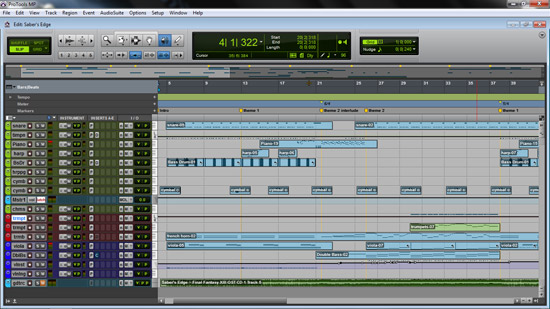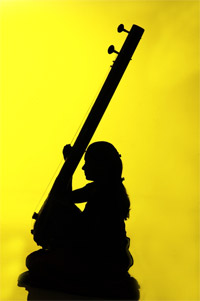Orchestral Study with East West Symphony
After installing the whole East West orchestral pack, I was anxious to try and learn and start using it. Instead of trying to create something from scratch, I thought it might be beneficial to do a study of another song. I tried to pick a song that had a fair amount of complexity and instruments, so I could give a stress test on my machine. I picked a song by composer Masahashi Hamauzu titled “Saber’s Edge”.
When he recorded the song originally, he actually combined a live orchestra with programmed instruments, so it is going to be pretty hard to reproduce exactly. This post is talking about some of the journey I took in trying to learn the new tool and recreating an existing song from scratch.

Dealing with a lot of different tracks and instruments can get messy fast. I found it is best to really start organizing your instruments and put them into groups. I separated the instruments into brass, woodwinds, percussion, and strings sections. Using different articulations with instruments required separate tracks, so it I always tried to put the articulations of an instrument in the name if there were multiple types. I also color coded the instruments to visually be able to tell what the sections were.
The light blue tracks were my master fader and the guide track. The guide track was the original song that I could toggle on and off to see how my version compared sonically.
I am starting to develop a process on composing/studying songs. The main steps I am using are the following:
- Time/key signature
- instrument pitch recordings (emphasis on pitch)
- mixing (emphasis on volume and emphasis) - screenshot below

Saber’s edge took a little while to get the time signature down because it changed 5 or 6 times throughout the song. Each section changed a time signature. There was also a couple bars that had odd time signatures like one with 7/4 time followed by one bar with 5/4 time, then going to 6/4 time afterwards. It had a pretty steady beats per minute(BPM) of 156, so that didn’t take too long to figure out.
How does an Instrument Sound?

One of the difficult parts of recreating a song is hearing an instrument and knowing exactly which instrument is playing. There seems to be many instruments that have similar range and timbre, so I really had to listen to the sounds to hear overtones and other characteristics that make an instrument distinct.
It was especially hard with some of the mid range instruments. The cello, viola, and trombone sometimes all share some of the same range, so it can be hard to differentiate them at times.
If the instrument has a brassy sound, I know it is a brass instrument, but an intrument like the french doesn’t have a brassy sound when played at moderate volumes. This makes it almost sound like a stringed instrument at times. It might not matter if one instrument is wrong, but the cumulative effect of multiple instruments really make the texture of the music change.
Another important aspect I am seeing more from composing is the value of the mid frequency range. I played the song on a few different systems, and noticed many of them do a poor job at picking up lower frequencies.
This really impact the sound of the music when the bass had the foundation. My muscles were twinging when I heard how empty some sections felt on ear buds or a lower quality computer speakers.
I liked the balance of the instruments when I heard it, but just wanted to make it bigger/louder sounding overall. I ended up using a compressor on the entire track and adding a gain boost to increase the overall levels. This decreased the dynamic range of the song. The dynamic range is the difference between the loudest sound and the quietest sound in a passage or song. Decreasing the range makes the quieter sounds louder and the louder sounds quieter. This helped fill in some of the void and made it easier to distinguish between the different instruments.
Finished version
Page Contents

I mostly keep this blog to help me remember things. Writing is also a great way to understand things at a deeper level. I would highly recommend it if you don't write at all.